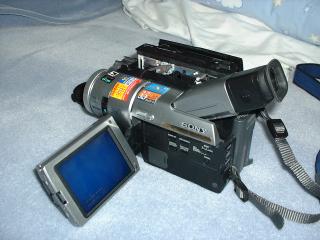 Science Daily: Uranus
Science Daily: Uranus
- New images reveal what Neptune and Uranus really look like January 5, 2024
- Ringing in the holidays with ringed planet Uranus December 19, 2023
 Science Daily: Pluto
Science Daily: Pluto
- How Pluto got its heart April 15, 2024
- Evidence of geothermal activity within icy dwarf planets February 15, 2024
 Science Daily: Kuiper Belt
Science Daily: Kuiper Belt
- How Pluto got its heart April 15, 2024
- Evidence of geothermal activity within icy dwarf planets February 15, 2024

 We originally purchased the Sony DCR-TRV310 for home video of family events. On a lark, I decided to point it into the eyepiece on night and was pleasantly surprised that I got reasonable images. It just so happened that I picked the moon as a target and it was only slight after the new moon. This was fortunate in that the entrance pupil of the camera is not well matched to the exit pupil of the 25 mm Plossl eyepiece I was using (25 mm with an f/6 scope gives an exit pupil of 4.2 mm, rather large for the video camera).
We originally purchased the Sony DCR-TRV310 for home video of family events. On a lark, I decided to point it into the eyepiece on night and was pleasantly surprised that I got reasonable images. It just so happened that I picked the moon as a target and it was only slight after the new moon. This was fortunate in that the entrance pupil of the camera is not well matched to the exit pupil of the 25 mm Plossl eyepiece I was using (25 mm with an f/6 scope gives an exit pupil of 4.2 mm, rather large for the video camera).
When the full image cannot enter the camera, you end up with a shadow from the secondary in your images. But, because I was imaging a very thin crescent moon, the shadow from the secondary fell in the dark part of the moon so I couldn't tell. And, because I couldn't tell, I went on to try imaging Jupiter and Saturn.
Sorry, I don't have any technical details on the Sony DCR-TRV310, but once I do, I'll try to post them here.
Using the DCR-TRV310
For the planets, the DCR-TRV310 can be used in the normal 29.97 frames-per-second mode. For deep-sky objects the camera's "candle-light" mode is preferable. In this mode, the camera increases the exposure time by approximately a factor of 8 to produce 1/4-second exposures. Output continues at the 29.97 fps rate, but each set of 8 frames is identical.
The DCR-TRV310 has three output methods, composite video, S-Video, and FireWire. The latter is preferred as it is completely digital and what was used. Capturing over the digital FireWire connection makes it easy to get rid of duplicate frames when using the candle-light camera setting; each set of 8 frames is completely identical and any tool which will allow you to compare files will tell you which ones are unique.
Because the DCR-TRV310 is a standalone camera, you don't need any computer at the site to do your video capture; just a supply of digital 8-mm tapes and your telescope.
Written by Roland Roberts
Search
.Archives
- May 2024 (2)
- April 2024 (3)
- September 2022 (5)
- April 2022 (1)
- January 2022 (3)
- December 2021 (4)
- September 2021 (3)
- July 2021 (1)
- January 2021 (1)
- November 2020 (2)
- October 2020 (2)
- September 2020 (2)
- August 2020 (5)
- July 2020 (1)
- November 2019 (2)
- September 2019 (1)
- August 2019 (2)
- September 2017 (1)
- August 2017 (1)
- September 2015 (3)
- August 2015 (2)
- June 2015 (5)
- May 2015 (3)
- May 2013 (2)
- January 2013 (1)
- December 2012 (2)
- September 2012 (1)
- June 2012 (1)
- May 2012 (1)
- October 2011 (2)
- September 2011 (2)
- April 2011 (2)
- March 2011 (10)
- January 2011 (8)
- November 2010 (2)
- October 2010 (1)
- September 2010 (3)
- August 2010 (2)
- July 2010 (1)
- June 2010 (1)
- April 2010 (3)
- February 2010 (3)
- January 2010 (3)
- December 2009 (6)
- November 2009 (3)
- October 2009 (7)
- September 2009 (8)
- August 2009 (4)
- July 2009 (1)
- June 2009 (2)
- May 2009 (2)
- April 2009 (7)
- March 2009 (1)
- February 2009 (6)
- January 2009 (4)
- December 2008 (4)
- November 2008 (3)
- October 2008 (11)
- September 2008 (4)
- August 2008 (5)
- July 2008 (5)
- June 2008 (2)
- April 2008 (4)
- March 2008 (18)
- February 2008 (9)
- November 2007 (1)
- October 2007 (3)
- July 2007 (3)
- April 2007 (1)
- March 2007 (6)
- February 2007 (3)
- December 2006 (3)
- October 2006 (4)
- September 2006 (1)
- July 2006 (5)
- May 2006 (10)
- April 2006 (9)
